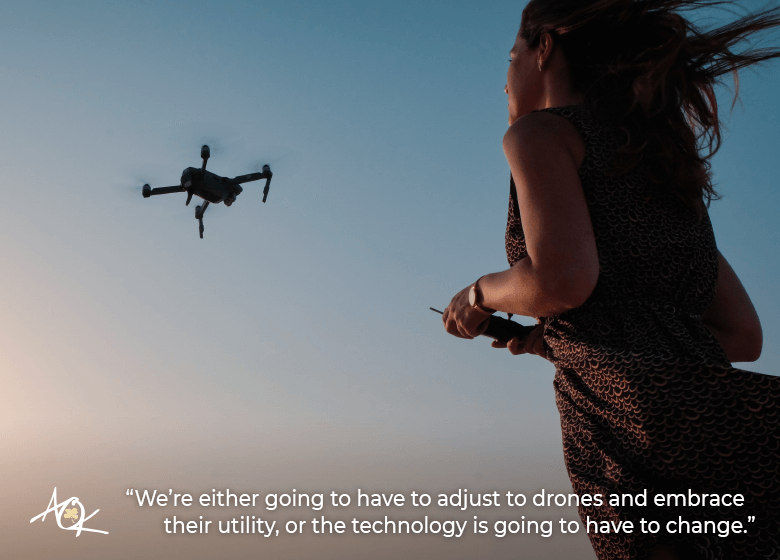The future is here, and as much as I embrace new technology on a daily basis to help our clients market their businesses, it doesn’t detract from tech’s potential to be more than a little creepy at times.
That’s the conclusion I gleaned from an odd encounter in my backyard recently, one that reminded me that even the most seemingly indispensable new technological or business innovations need to be properly packaged and sold if they’re to gain widespread adoption.

So, let me explain.
There I was enjoying a beautiful spring day on my back patio when a high-pitched buzzing sound cut through the air. I figured it was a bee or wasp until it grew louder.
I looked around and eventually up to the sky where I was able to discern a small dot high in the air. It was a drone hovering overhead. The controller was nowhere to be found. The drone hung there for a minute or two, then slowly travelled back the way it came until it was out of sight and out of ear shot.
Was someone playing with a new toy? Were they filming my moments of backyard bliss?
I’ll never know, but what I can confirm is that the whole experience left me feeling a little violated, a little anxious—what would have happened if the battery died suddenly and it fell out of the sky?—and reminded me of an earlier high-tech encounter that also produced mixed emotions.
That was the first time I encountered someone wearing Google Glass. Watching someone not only watch you, but potentially record your every movement without consent is disconcerting—cool in concept, but strange and unnerving when applied in the real world, leaving more questions than answers.
That’s where we are now with drone technology. We’re either going to have to adjust to its invasiveness and embrace its utility, or the technology is going to have to change. What I do know is that drones aren’t going anywhere.

That’s because drone technology has the potential to change the world. Think about package delivery, alone. It’s now possible to deliver life-saving medicines to remote areas in extreme conditions using these unmanned vehicles.
We’ve already seen Amazon.com experiment with drones to make rapid deliveries. Think about the cost savings and efficiencies. While drones are currently too small and weak to make a huge difference in our lives, their potential payloads will only increase over time.
Soon drones will be able to carry the weight of a human or heavier, over long distances, on a single charge. Perhaps your business will benefit from these devices, potentially even allowing you to augment—or replace—an existing delivery team or employees engaged in basic, labour-intensive work. The possibilities are endless.
But here’s the catch: unless we take the time to communicate the benefits of a new technology such as this one to our clients and the masses, it could take far longer than is reasonably necessary for these tools to be adopted and put to good use.
The simple reason is that people are generally resistant to change. Technological advancements can move forward at a lighting pace, but humans’ ability to keep up is limited by everything from our capacity to understand and accept the new tools at our disposal, to the time needed to regulate their appropriate use.

Despite rapid advancements in e-commerce technology, for example, only 3.1 per cent of the retail goods sold in Canada this past January were bought online, according to Statistics Canada. That represents a year-over-year increase of 14.8 per cent, but only underscores the fact that despite huge e-commerce investments on the part of leading retailers, many of us simply prefer to shop at the mall.
Will online giants such as Amazon.com eventually supplant traditional brick-and-mortar retailers? Bet on it—but in the meantime, remember that old habits die hard.
Artificial intelligence is another emerging technology that’s causing huge changes in everything from consumer interactions to marketing. As rapid as advancements in AI are, however, machine learning software still has the potential to alienate customers who recoil at the thought of interacting online with a bot rather than a live human, or having their data mined and shared in even more intrusive ways.
Some companies will likely try to shun AI technology and leverage an old-school approach to their advantage—‘Email us for a quote and we’ll guarantee you’ll speak to a real, live sales agent!’
So, until we spend the time to communicate why new tools such as drones are necessary, market their benefits and make customer interactions seamless and comfortable—not to mention implementing rules and regulations to protect privacy, among other key considerations from both a business and social perspective—our tech interactions could remain a little awkward.

About The Author
Marketing Team
The AOK Marketing Team is a diverse group of amazing individuals driven to help all of our clients succeed. Great people are everywhere, and we believe that people should control their workday, their work environment, and where they live. We have team members in 9 countries: United States, Canada, Egypt, Belgium, Ireland, Australia, India, Pakistan, and Hong Kong.
How can we help you?






